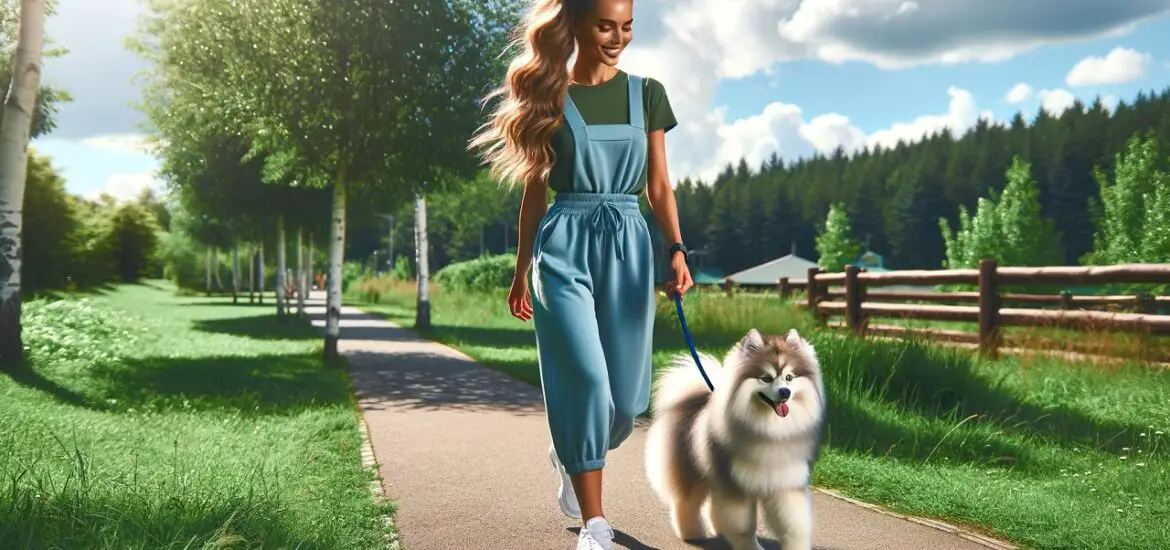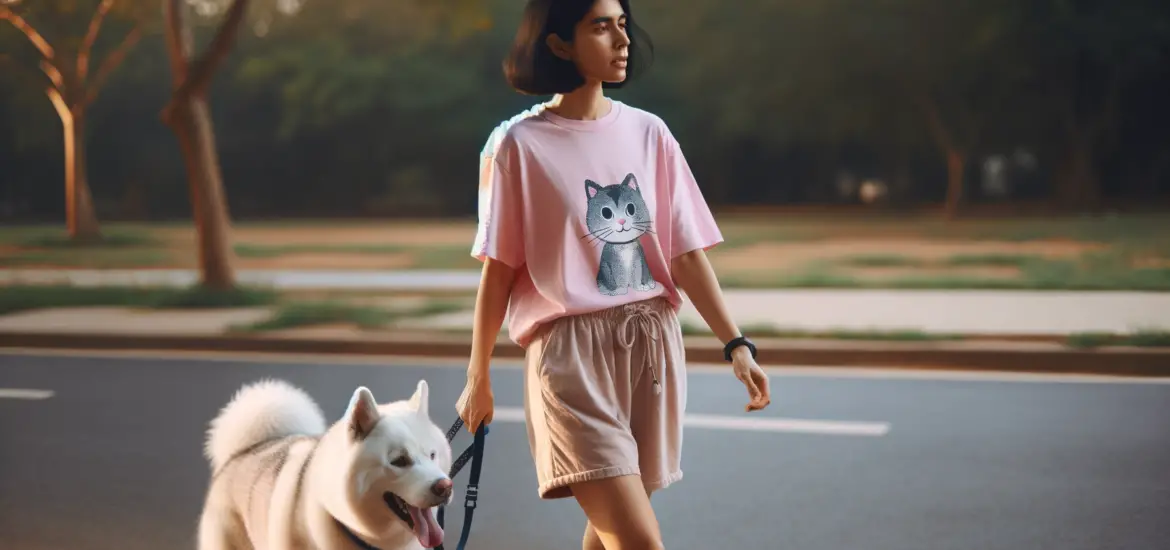If you’re wondering how to get your dog to follow you on leash, this detailed guide will provide you with a step-by-step approach to leash train your dog.

Table of Contents
Step 1: Choosing the Right Gear
The right gear can make all the difference in leash training. A properly fitted collar or harness and a sturdy leash set the tone for a successful training session. The key is to select equipment that is comfortable for your dog and provides you with adequate control.
When selecting a collar, measure your dog’s neck and add two inches to the measurement to ensure it fits comfortably, without slipping off or causing chafing. Collars come in various materials, with nylon and leather being the most durable and comfortable. For dogs that pull excessively or have respiratory issues, a harness may be a better option. Harnesses distribute pressure more evenly across the chest and shoulders, reducing strain on the neck. Make sure the harness fits snugly but doesn’t restrict your dog’s movement or breathing.
There are several types of leashes to consider as well. Standard leashes are typically four to six feet in length and are ideal for training and everyday walks. Retractable leashes can offer more freedom, but they don’t provide as much control, which is essential during training. A leash made of leather or woven nylon is both strong and durable, which is important for maintaining control and ensuring safety.
Remember, the gear you choose should aid in the training process, not hinder it. If your dog seems uncomfortable or is not responding well to a certain type of collar, harness, or leash, it may be necessary to try different gear. Consult with a professional trainer or your veterinarian for advice on the best types of equipment for your dog’s breed, size, and temperament.
Step 2: Creating a Positive Association
Positive reinforcement is a powerful tool in dog training. By associating the leash and collar/harness with positive experiences, your dog will learn to look forward to walks with you. This technique involves rewarding your dog for desired behaviors, which encourages them to repeat those behaviors in the future.
To start, choose treats that your dog loves and reserve them specifically for leash training sessions. This will help your dog make a clear connection between the special treats and the leash and collar/harness. Each time you bring out the leash, give your dog a treat, even before you put the collar or harness on. This builds excitement and anticipation around the leash itself.
When you place the collar or harness on your dog, continue to offer praise and treats. If they remain calm and allow you to put it on without fuss, give them a treat. The same goes for attaching the leash. Keep the mood light and encouraging; use a cheerful voice and plenty of petting to convey your approval.
Once your dog is comfortable wearing the collar or harness with the leash attached, begin using treats to guide them around your home. Lead them to areas where they feel happy and safe, like their bed or the spot where they usually eat. As they follow you, give them treats and praise. This not only reinforces the idea that following you is positive but also that the leash is a part of this good experience.
Remember to keep training sessions short, especially in the beginning. Aim for five to ten minutes to prevent your dog from becoming bored or overwhelmed. Always end on a positive note, with a treat and affection, so that your dog retains a strong positive association with the leash and training process.
Over time, these positive reinforcement strategies will lead to a dog that not only follows you on a leash but does so eagerly and with excitement. By using treats and affection strategically, you create a solid foundation for a lifelong positive walking experience with your dog.
End the training session on a positive note, even if it’s just for a single successful follow, and try again later. With persistence, your dog will learn that walking nicely on a leash leads to good things, and treats will become a secondary pleasure to the joy of walking with you.
Step 3: Practicing Inside
Beginning leash training within the confines of your home provides a controlled environment with fewer distractions, allowing your dog to concentrate on learning the basics of good leash behavior. Indoor training lays the groundwork for outdoor walking by establishing fundamental skills in a setting that is comfortable and familiar to your dog.
To start, choose a quiet room with minimal distractions. Ensure the space is clear of obstacles that could trip you or your dog. Use gates if necessary to confine the training area, so your dog doesn’t wander off. The goal is to create a calm environment where your dog can focus solely on you and the training cues.
With your dog on a leash, begin walking them around the room. Encourage them to walk by your side rather than in front or behind. A relaxed leash is key; it should form a ‘J’ shape between you and your dog. This indicates that there’s no tension from either end. If your dog starts to pull, stop walking. Resume only when the leash is slack again. This teaches your dog that pulling won’t get them anywhere, whereas a loose leash will move them forward.
Use treats and your voice to guide and reward your dog for maintaining the correct position and a relaxed leash. If they walk nicely beside you, offer praise and a treat. This positive reinforcement helps your dog associate a loose leash with pleasant outcomes. Practice turning and stopping frequently so your dog learns to follow your pace and direction changes without tension on the leash.
Indoor training can also involve navigating through household obstacles, like furniture, which can serve as practice for outdoor distractions. Set up a mini obstacle course or simply weave through furniture to teach your dog to follow your lead, even when the path isn’t straightforward. This exercise enhances your dog’s attentiveness and their ability to work in harmony with you.
Remember to keep training sessions short, especially in the beginning. Aim for five to ten minutes to avoid overwhelming your dog. Gradually increase the duration of the training as your dog’s endurance and attention span grow. Consistent, short sessions will lead to better retention of the behaviors you’re teaching.
Indoor leash training is an excellent precursor to the great outdoors. It allows your dog to master the art of walking on a leash in a less challenging environment, setting both of you up for success when you’re ready to transition to more complex and distracting outdoor walks.
For more articles like this one click here – How to Get Your Dog To Do What You Want: Your Ultimate Guide to Dog Training and Care

Step 4: Moving Outdoors
Once you and your dog have mastered walking indoors, it’s time to take the training outside. This is where your dog’s skills will be put to the test with new distractions and challenges. The transition from a controlled indoor environment to the unpredictable outdoors can be exciting for your dog, but it’s important to maintain the structure and consistency you’ve established.
Begin in a quiet outdoor area to minimize distractions. Your backyard or a less frequented park during off-peak hours are good starting points. Keep the initial outdoor sessions short, just like when you started indoors. Equip yourself with the same treats and enthusiasm that helped you succeed inside.
As your dog adjusts to the new environment, they may become more excited or distracted. This is natural. Patiently bring their focus back to you with commands they’ve learned. If they pull or wander, stop walking and call them back to your side. Reward them with treats and praise for returning their attention to you.
Gradually introduce more challenging environments, like busier streets or parks, once your dog seems comfortable and is reliably following your cues in the quieter setting. Always watch your dog’s body language for signs of stress or overstimulation and retreat to a calmer environment if needed. The goal is to build positive outdoor walking experiences, not to overwhelm your dog.
During walks, practice the ‘sit’ and ‘stay’ commands frequently. This not only reinforces control but also gives your dog a moment to calm down if they’re overexcited. It’s also beneficial to vary your walking speed and change directions. This unpredictability keeps your dog focused on you, reinforcing the idea that they need to pay attention to where you lead.
Remember, consistency is key. Always use the same commands and reward system that you established indoors. This helps your dog understand that, regardless of the environment, the rules and expectations remain the same.
As you progress, slowly increase the duration and complexity of your walks. Include routes with more people, other dogs, and different terrains. With patience and consistent reinforcement, your dog will learn to follow your lead reliably, even in the most distracting of outdoor settings.
Finally, don’t forget to enjoy this time with your dog. Outdoor walks are not just a training exercise; they’re an opportunity to bond and explore the world together. With each step, you’re reinforcing trust and companionship, essential components of a happy, obedient dog.
Step 5: Increasing Distractions Gradually
As your dog grows more adept at leash walking in controlled environments, it’s time to incrementally introduce them to the real world’s distractions. Doing this gradually helps your dog learn to maintain focus on you and your commands, even in the face of interesting or exciting stimuli.
Start with minor distractions in an environment where you can control the intensity and frequency. This could be as simple as having another person walk across the room or tossing a toy nearby during your indoor training sessions. Reward your dog for maintaining focus on you despite these distractions. Positive reinforcement here is crucial—it teaches your dog that paying attention to your cues is more rewarding than the distraction itself.
Once your dog shows consistent success indoors, move to a fenced outdoor area with more distractions. The presence of natural stimuli like birds, squirrels, and other animals can be challenging, so keep the training sessions short and sweet. Use high-value treats to capture and hold your dog’s attention in these higher-distraction environments.
It’s important to build up the level of distraction gradually. If your dog fails to respond to your commands, it may mean that the distraction is too intense or you’ve moved too quickly. Take a step back, reduce the level of distraction, and slowly build up to it again. Remember, training is not about testing your dog’s limits, but about setting them up for success.
Practicing in different locations can also be beneficial. Walk your dog in quiet areas first, then progressively move to busier streets. Each new environment will bring its own set of distractions, and exposing your dog to a variety of settings can improve their adaptability and focus.
During these sessions, it’s essential to maintain a relaxed demeanor. Your dog can pick up on your emotional state, so if you’re anxious or tense, they’re more likely to be as well. Stay calm and use a cheerful voice to keep their attention on you. If they do get distracted, gently redirect their focus without frustration or anger.
By gradually increasing distractions and consistently reinforcing positive behavior, you’re teaching your dog that following your lead is the best choice, no matter the environment. This is not only beneficial for leash training but also for their overall behavior and responsiveness to you in any situation.
Step 6: Consistency is Key
In the process of leash training, or any form of dog training for that matter, consistency is not just beneficial—it’s essential. A consistent routine, regular training sessions, and unwavering use of commands form the cornerstone of successful training regimens, providing your dog with the structure they need to learn and thrive.
A consistent routine helps your dog understand what is expected of them and when. This means having set times for walks, meals, and training sessions. Dogs are creatures of habit, and a predictable schedule can greatly reduce their anxiety, making them more receptive to learning. For leash training, try to practice at the same time each day so your dog can anticipate the activity, further reinforcing the positive aspects of the training.
Regular training sessions are equally important. They should be frequent enough to keep the learned behaviors fresh in your dog’s mind but not so frequent that they become a source of stress for either of you. Typically, two to three short sessions (10-15 minutes each) daily are recommended to reinforce the commands and behaviors you’re teaching without overwhelming your dog.
When it comes to commands, consistency means using the same word or signal for a specific action every time. If you use “come” one day and “here” the next, you’ll confuse your dog. Decide on a set of commands before you begin training and stick to them. This clarity helps your dog understand and respond appropriately to your cues.
Also, ensure everyone involved in the dog’s life is on the same page. If family members or friends use different commands or reward behaviors inconsistently, it can set back your training. Have a meeting with everyone who will interact with the dog to ensure consistency in approach and commands.
Consistency extends to the consequences of your dog’s actions as well. Always reward good behavior promptly with treats, praise, or playtime, and be sure to withhold these rewards if the desired behavior is not displayed. Remember, the reward should immediately follow the good behavior to create a strong association.
Lastly, be patient and consistent with your expectations. Training is a process, and each dog will progress at their own pace. Celebrate the small victories and remain consistent in your approach, and with time, you will see your dog walking on a leash beside you, following your lead with trust and confidence.

Step 7: Addressing and Correcting Pulling
If pulling persists during walks, it’s crucial to address and correct the behavior in a calm and firm manner. Ensuring that this correction does not cause stress or fear is essential for maintaining trust and a positive learning environment. Consistent pulling can be frustrating, but remember, patience is key to successful training.
Start by assessing the situation when pulling occurs. Is there a particular trigger or environment that encourages this behavior? Understanding these factors can help you anticipate and prevent pulling before it starts. Once you’ve identified potential triggers, you can work on specific training exercises to address them.
One effective technique for correcting pulling is the ‘stop-and-go’ method. When your dog starts to pull, stop walking immediately. Stand still and do not allow the walk to continue until there is slack in the leash again. This teaches your dog that pulling will not get them where they want to go faster. As soon as the leash is slack, praise your dog and continue walking. If they pull again, repeat the process. Over time, your dog will learn that walking calmly by your side is the fastest way to move forward.
Another technique is the ‘change direction’ method. When your dog begins to pull, change direction and walk the other way. This redirects their focus back to you and reinforces the concept that they must follow your lead. This method also encourages your dog to pay closer attention to your movements rather than the environment.
Training tools like no-pull harnesses can also be beneficial. These harnesses are designed to gently redirect your dog’s movement without causing harm when they pull. It’s essential to choose a well-fitting harness and introduce it to your dog gradually, allowing them to get used to the feel before starting your training walks.
While these tools can aid in training, they are not substitutes for consistent training practices. Use them in conjunction with training techniques rather than relying on them solely to prevent pulling.
It’s important to avoid negative reinforcement, such as yelling or jerking the leash, as this can lead to fear and anxiety, which are counterproductive to training. Instead, focus on positive reinforcement techniques. Reward your dog with treats and praise for walking nicely without pulling. This positive association will encourage them to continue the good behavior.
Correcting leash pulling requires consistency, patience, and a positive attitude. By employing these techniques and tools, you can teach your dog to walk on a leash without pulling, creating a more enjoyable and stress-free walking experience for both of you.
Step 8: Seeking Professional Help if Needed
There’s no shame in seeking the help of a professional. Sometimes, a little extra guidance can make a big difference.
Conclusion: How to Get Your Dog to Follow You on Leash
Leash training your dog is a journey that requires patience, consistency, and positive reinforcement. Remember, each dog is unique, and what works for one may not work for another. Stay patient, be consistent with your training, and celebrate the small victories along the way. With time and practice, your walks will become the enjoyable and bonding experiences they are meant to be.
